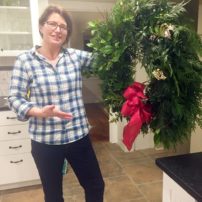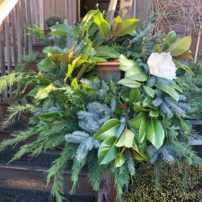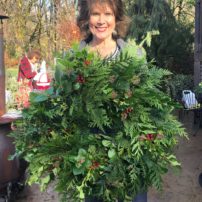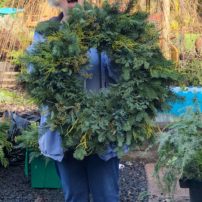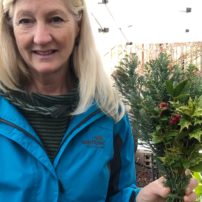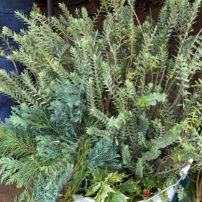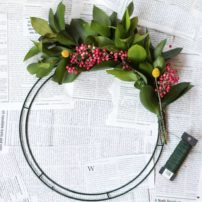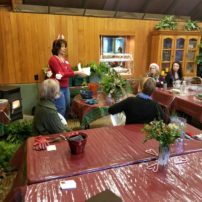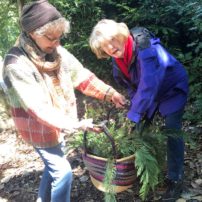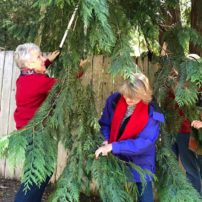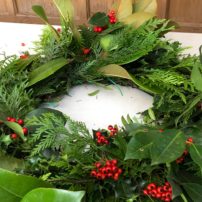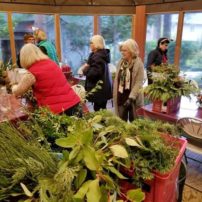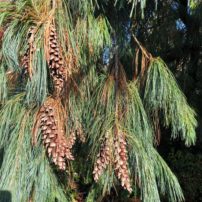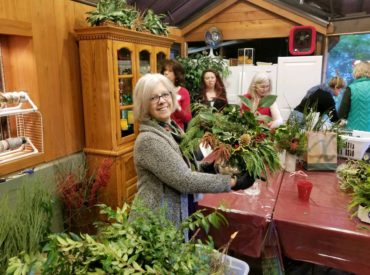 Winter brings long, dark days, and historically humans have found ways to chase away the darkness. The tradition of festooning homes with evergreen boughs, berries and cones dates back to pagan times.
Winter brings long, dark days, and historically humans have found ways to chase away the darkness. The tradition of festooning homes with evergreen boughs, berries and cones dates back to pagan times.
In Europe, pre-Germanic people gathered evergreens because they are sturdy, last long and stay green until spring. Using natural winter berries for color and candles for light, a wreath eventually evolved into today’s Advent Wreath.
A log was burned at the solstice to welcome the return of the light, a practice that evolved to become the burning of the Yule log. There was even a character in early English folklore, clad in animal skins and going door to door with greens and twigs to spread winter cheer.
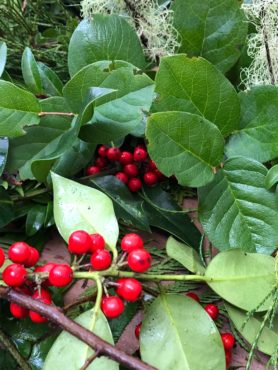 Tradition says that hymns such as “The Holly and the Ivy” and “Deck the Halls” originated from this legend, which also seems to have connections to the “Green Man.” This figure, popular in the stone carvings of Lincolnshire Cathedral, may have eventually become “Father Christmas,” a character different from the “Sinterclaas” bringing gifts to children in mainland Europe.
Tradition says that hymns such as “The Holly and the Ivy” and “Deck the Halls” originated from this legend, which also seems to have connections to the “Green Man.” This figure, popular in the stone carvings of Lincolnshire Cathedral, may have eventually become “Father Christmas,” a character different from the “Sinterclaas” bringing gifts to children in mainland Europe.
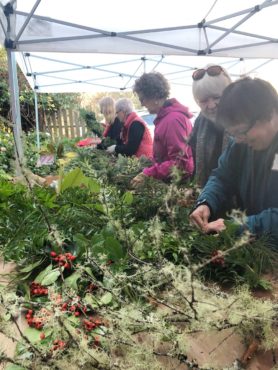 Today, people drape garlands twisted with white twinkly lights on their front porches, hang wreaths on their doors and place centerpieces on their tables to chase away the dark and cold of the winter months. These decorations are easy to make, and lots of fun with friends.
Today, people drape garlands twisted with white twinkly lights on their front porches, hang wreaths on their doors and place centerpieces on their tables to chase away the dark and cold of the winter months. These decorations are easy to make, and lots of fun with friends.
Consider throwing a “winter greens party” — just invite a few friends and take a trek into the woods or greenbelt to cut fir branches, pine boughs, holly, berries and long-lasting greens. Collect a few containers and wreath forms, assemble some tools, ask everyone to bring an appetizer — and a party is born.
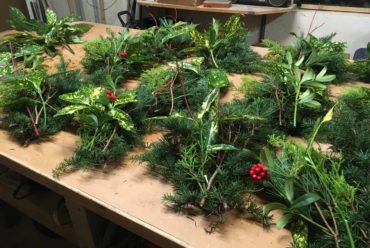 Winter decor and wreath making parties are a tradition in New England and are quickly gaining popularity in the Northwest. The Harbor Gardeners Club in Gig Harbor has been hosting a wreath-making party in early December for about 10 years. Many other individuals have taken advantage of the plethora of local evergreen plants, along with natural berries and lichen-laden branches, to dress their homes in wreaths and centerpieces that last for weeks and bring color throughout the winter season.
Winter decor and wreath making parties are a tradition in New England and are quickly gaining popularity in the Northwest. The Harbor Gardeners Club in Gig Harbor has been hosting a wreath-making party in early December for about 10 years. Many other individuals have taken advantage of the plethora of local evergreen plants, along with natural berries and lichen-laden branches, to dress their homes in wreaths and centerpieces that last for weeks and bring color throughout the winter season.
Arlene West of Floral and Foliage in Silverdale teaches classes in seasonal decor. Her classes have become so popular, she has created a classroom to accommodate guests and materials. Her holiday-decor classes take on a party atmosphere designed to get everyone into the holiday spirit.
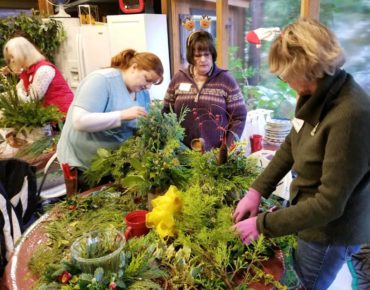 How to Host a Party
How to Host a Party
At home, a successful greens party consists of a congenial group of friends; plenty of tools for cutting; wreath forms or containers for table centerpieces; wires and glue guns for fixing all the parts together; scissors, pliers and small pruners; lots of embellishments such as ribbons, balls, and bells; table space on which to work; and refreshments and beverages for relaxing when the work is done.
Nearly any combination of evergreen plants that can withstand cutting, wiring or gluing, and being out of water for a long period of time will do. Now is a good time to prune the holly, boxwood or salal that is growing out of bounds. Conifers of any sort — Douglas fir, Western red cedar, any variety of pine or spruce — may also serve as the foundation to showcase the embellishments of cones, berries, ribbons and even silk flowers.
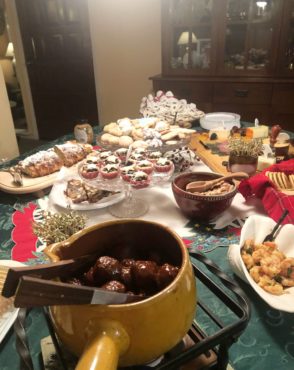 To host a winter greens party, send invitations a few weeks in advance to give guests an opportunity to think about what sort of decoration they would like to make for their home, gather embellishments and plan what they will bring for the refreshment potluck.
To host a winter greens party, send invitations a few weeks in advance to give guests an opportunity to think about what sort of decoration they would like to make for their home, gather embellishments and plan what they will bring for the refreshment potluck.
Collecting Materials
If natural materials are not available at the party site, ask guests to bring what they have in their gardens or greenbelts. Some guests will not have much access in the way of greenery to contribute while others may have an abundance, so encourage them to bring lots of extras.
Cover work tables with a protective layer of newspaper or plastic to prevent dirt, scratches, glue and sap from damaging the table surface. Provide tubs or boxes to hold cuttings and keep them from spreading out and getting under foot.
Set up the refreshment area with a beverage bar and a place for guests to put their prepped food dishes, including napkins, plates, cutlery and glassware.
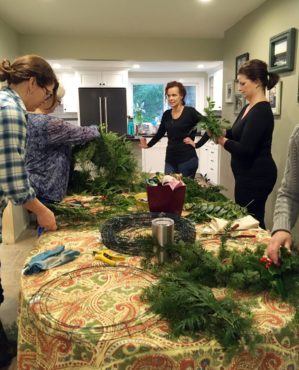 If possible, the next step is to go out into the woods, along roadsides or into a greenbelt to cut fresh greens such as fir, spruce, hemlock, cedar and pine boughs. There is no need to cut long branches, as the tips are the most attractive when worked into wreaths and table centerpieces.
If possible, the next step is to go out into the woods, along roadsides or into a greenbelt to cut fresh greens such as fir, spruce, hemlock, cedar and pine boughs. There is no need to cut long branches, as the tips are the most attractive when worked into wreaths and table centerpieces.
Gather cones and look for bare twigs covered with lichen and other interesting materials to incorporate into an arrangement. Evergreen leafy plants such as huckleberry, salal and holly are also prevalent in green belts or forested areas.
Greens gathering is a fun and exhilarating part of a greens party, sharing with friends the discovery of the bounty of the Northwest. Gather the greenery into baskets and bags, sorted into length and type to make selections easier during the design process.
For those bringing materials from home, beautyberry, pyracantha berries, nandina berries and rose hips are among the colorful additions that may be available. Gardeners also prize camellia, laurel, magnolia, rhododendron, jasmine and lonicera as a few of the sturdy evergreen foliages to cut in winter.
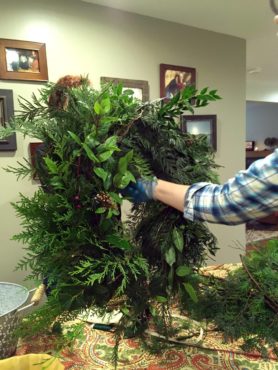 Wreath Techniques
Wreath Techniques
Some avid wreath makers have a mechanical machine mounted on a table to crimp greenery onto a wire base. Failing a mechanical system, wire wreath forms are available at craft shops and florists. Foam wreath bases and grapevine wreaths can also be used to give the greenery shape and substance.
A tried-and-true method for assembling wreaths is to begin by making a dozen or so bundles of the foundation material 1/3 to 1/2 the length of the diameter of the finished wreath. Cut greens into similar lengths depending on the desired finished size of the wreath and secure the bundles with florist wire by wrapping the bundle about 2 inches above the cut stem end.
Wrap several times around the bundle and tightly twist the wire to hold it in place. Wire the first bundle onto the wreath form at about a 45-degree angle. Overlap the wired end of the first bundle with the “loose” end of the second, and wire the second bundle into place. Continue around the form until it is completely covered and the wreath is full and flush.
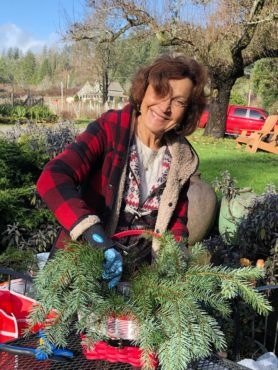 When the foundation of the wreath is finished, it is time to add embellishments. Pine and fir cones, the berries of nandina, holly and skimmia japonica add a natural look, while silk flowers such as magnolia blossoms or poinsettias offer a more floral flair. Frosted or beaded artificial fruits or glass Christmas balls can add a bright and colorful note.
When the foundation of the wreath is finished, it is time to add embellishments. Pine and fir cones, the berries of nandina, holly and skimmia japonica add a natural look, while silk flowers such as magnolia blossoms or poinsettias offer a more floral flair. Frosted or beaded artificial fruits or glass Christmas balls can add a bright and colorful note.
Adding embellishments is most easily done with a hot glue gun, as once the foundation is wired in place, it can be difficult to wire through the greenery. A florist trick is to make picks out of cones, ribbons, balls, etc. Floral picks, basically a small stick with a wire attached, are available at craft stores.
The wire can be wrapped around the end of a pine cone or berry sprig or fixed to a shiny bauble and then simply glued in place. Ribbon becomes the final touch to a wreath or swag. Loosely wrapped around the entire wreath and finished with a bow at the top or bottom will tie the arrangement together, but just a lavish bow will do nicely.
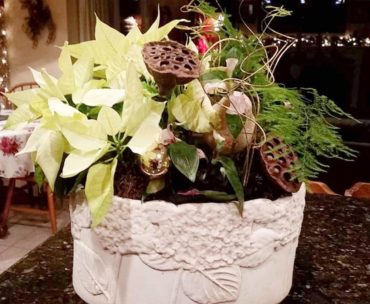 Table Arrangements
Table Arrangements
Table arrangements are another way to add a festive touch to the home. A centerpiece should complement the scale, color scheme and decor of the room where it will be placed. A large dining room with an impressive table can accept a centerpiece 24 inches or more in length. If the centerpiece will be left on the table during dining, care should be taken to make sure guests are able to see over the top of it.
Incorporating candles in the centerpiece adds a lovely glow, but safety measures are important. Enclosing the candle in a glass chimney or making sure the flame is well above the greenery is imperative. Of course, another solution is to use battery-operated candles, and several selections are available in the marketplace.
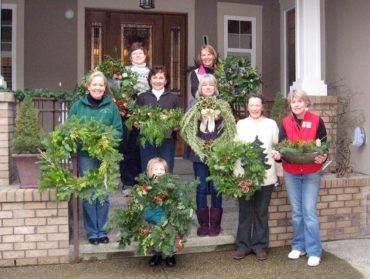 Small arrangements tucked onto side tables, a bedroom dresser or bathroom vanity also add a festive feel throughout the home. Using unusual containers such as a toy car for a child’s room or a beer stein on a bar will add interest and whimsey.
Small arrangements tucked onto side tables, a bedroom dresser or bathroom vanity also add a festive feel throughout the home. Using unusual containers such as a toy car for a child’s room or a beer stein on a bar will add interest and whimsey.
All container arrangements begin the same way. A floral foam block cut to size and secured with floral tape will hold the elements in place. Floral foam is soaked in water before placing in a container and taping to secure.
Begin by making a base of greenery, determining the length, width and height of the arrangement. If a candle holder will be installed, now is the time to place it.
 Fill in with various textures and colors of green for a rich foundation, leaving spaces between the stems for embellishments. Once the overall structure is defined, add a little more water to the container to keep stems moist.
Fill in with various textures and colors of green for a rich foundation, leaving spaces between the stems for embellishments. Once the overall structure is defined, add a little more water to the container to keep stems moist.
Begin to put in picks of cones, balls, berries and ribbon. A container arrangement done in this manner will last for several weeks if the water is topped up once a week or so. Wreaths or swags will dry out in a heated home and only last a couple of weeks. Arrangements will last for several weeks out of doors.
In any given group of friends, there will be at least one who has some wreath-making experience or another who has arranged florals. Another will have a creative eye for combining unusual materials for great impact. The important goal is to have fun, share friendships and maybe start a new tradition — all while using your hands and hearts to “deck the halls.”




